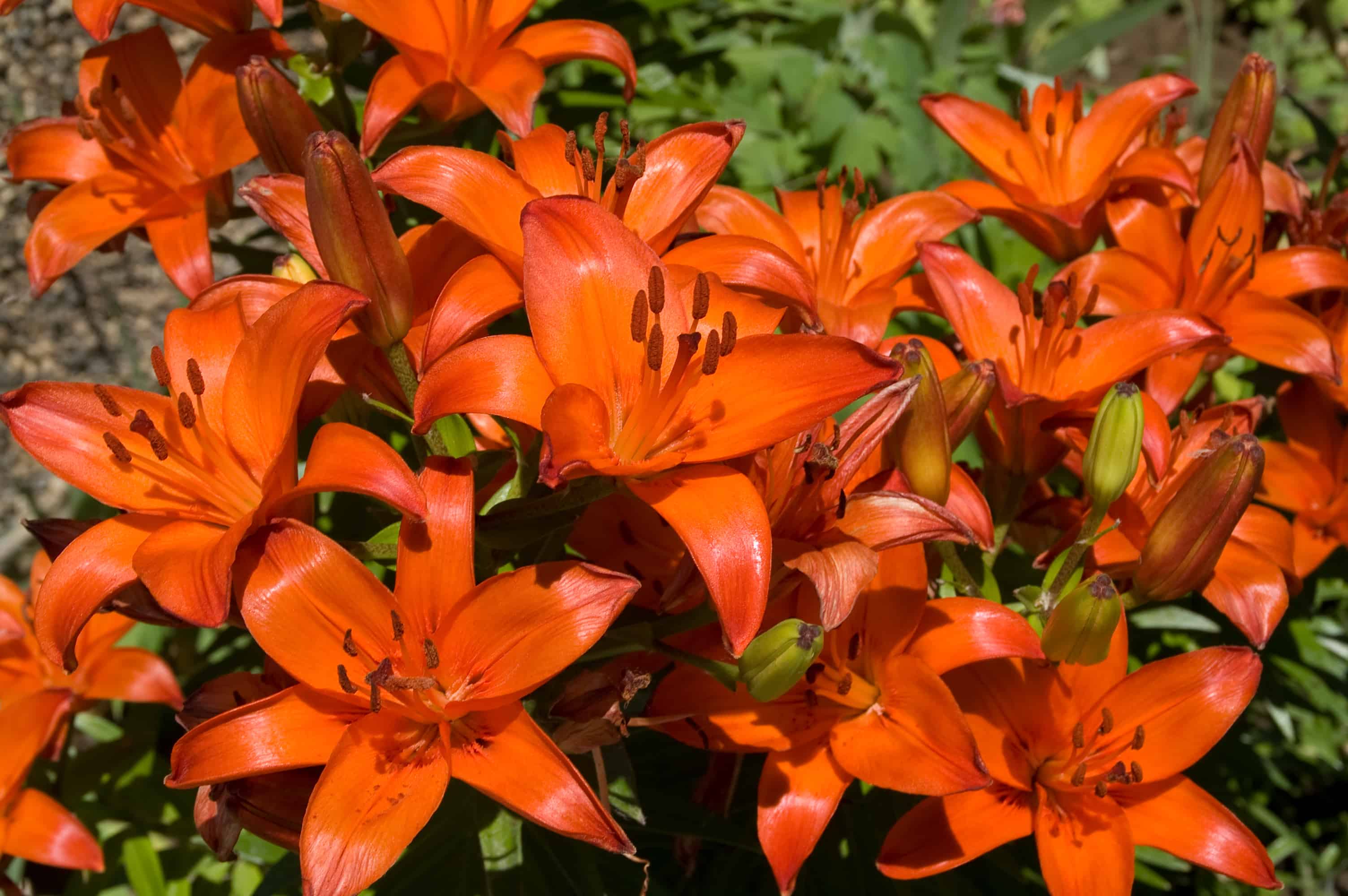The beauty of the many types of lilies has enthralled human beings for millennia. In the language of flowers, the white lily means sweetness and purity. Orange lilies mean warmth, love, and happiness. Lilies are placed around altars during Easter, and there’s even a type of lily called the Easter lily. At funerals, they represent the purification of the soul in death or the hope of the resurrection.
True lilies belong to the Lilium genus, a huge group that’s separated into 111 species and nine divisions. There used to be even more in the genus, but scientists have now consigned them to other genera. Lilies are amazingly widespread and are native to just about every continent, save Antarctica and South America. One thing to know about true lilies is that many are toxic to cats, dogs, humans, or all three, so it’s best to simply keep children and pets away from them. Here are the nine divisions of lilies.
1. Asiatic Lilies

Asiatic lilies are hybrids, so they’re not native to any one place.
©svf74/Shutterstock.com
Despite their name, Asiatic lilies are not native to Asia. Indeed, they’re not native to any one place as they’re hybrids. They are prized for their spectacular flowers, which come in shades of red, white, pink, orange, purple, or yellow. Asiatic lilies thrive in hardiness zones 4 to 9.
Asiatic lilies need full or partial sunlight and acidic soil that drains well. The soil needs to be kept moist but not soggy, so the flowers should be watered to one or two inches a week and fertilized in spring before they bloom. They don’t need to be pruned, so let the leaves die back in the winter. These tough plants can stand temperatures that dip to -35 degrees Fahrenheit, but they do best in temperatures above 50 degrees and below 90 degrees. The price for such hardiness is small: Asiatic lilies have no scent.
2. Easter Lilies
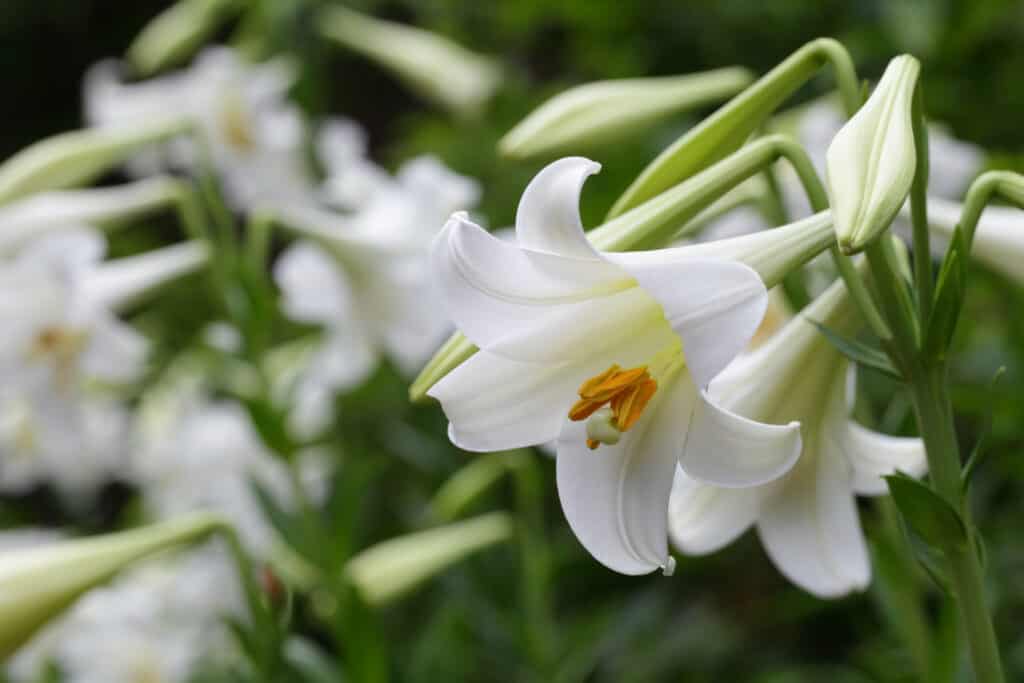
Sometimes Easter lilies are forced so they can bloom in time for Easter.
©COULANGES/Shutterstock.com
The scientific name for the Easter lily is L. longiflorum. It’s found naturally only on Taiwan and Japan’s Ryukyu Islands, though it’s been grown in other parts of the world since the early 19th century. The Easter lily is famous for its beautifully fragrant, usually white, trumpet-shaped flowers. These plants can grow a little over 3 feet tall, and their leaves are long and oval. The flowers appear in spring anyway, but they are often forced to be ready for Easter, which can be as early as March 22. Lilies that are forced are shorter than those allowed to grow naturally. A really healthy plant can put forth 12 to 15 flowers.
Easter lilies flourish in full sun, though they’ll need to be protected from scorching sunlight and can also do well in part shade. They like loamy, acidic to neutral soil that’s well drained. You should plant the bulbs a foot to a foot and half apart and 3 inches deep. Make sure to mulch the area to keep the soil cool.
You’ll need to remove the flowers when they’re spent, though when the leaves die back you should cut the stem down to the soil. It’s also a good idea to fertilize the area around the bulb with bulb fertilizer, though you should be careful not to damage the roots. Fertilize again in spring when you see shoots starting to poke above the soil. If you’re growing the lilies in an especially cold climate, mulch the area after a freeze, then remove it in the spring. Easter lilies grow best in hardiness ones 4 to 8.
3. Tiger Lilies
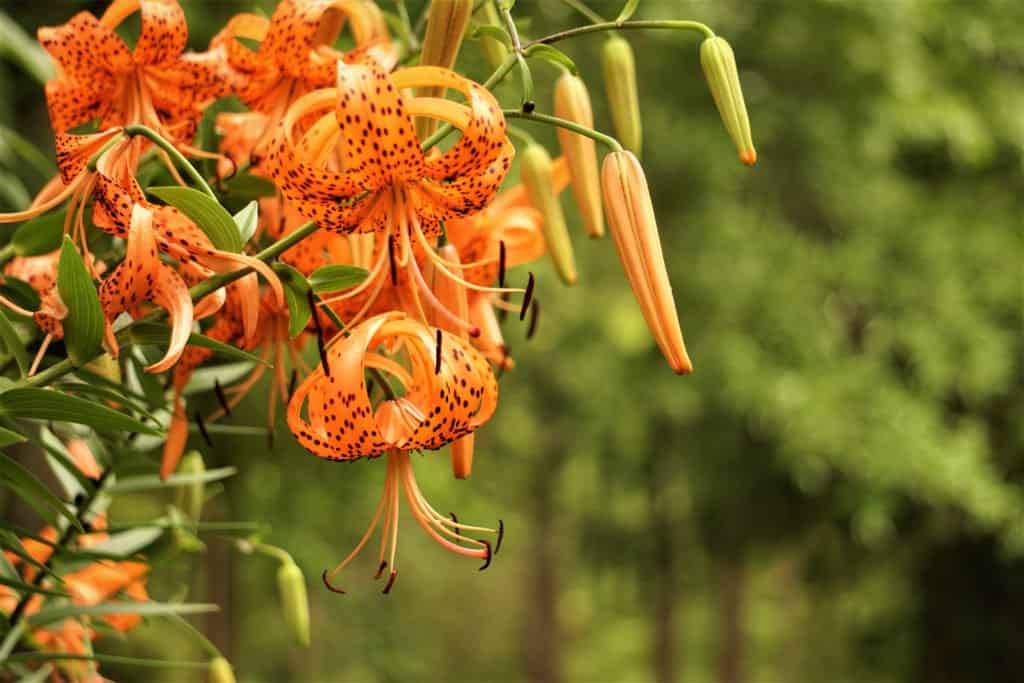
The orange and black of a
tiger
lily remind people of the big cat, but they can also be red or yellow.
©Ancha Chiangmai/Shutterstock.com
The scientific name of the tiger lily is L. lancifolium or L. tigrinum, and it’s native to Asia and the far eastern part of Russia. This plant grows 2 to 5 feet tall with a 7 to 8 inch widespread. Like other lilies, it thrives in full but not scorching sunlight or in partial shade and likes loamy, acidic soil that drains well. It also blooms in the summer, so you can plant it with spring-blooming lilies to prolong the blooming season. The tiger lily grows in hardiness zones 3 to 9. Interestingly, humans can eat the flowers of this plant, but the pollen is poisonous. The plant is also poisonous for cats, but not for horses or dogs.
The tiger lily differs from the Asiatic and Easter lilies in that its petals curve back and are spotted. Most varieties are orange, but they also come in yellow and red. They only bloom once in a season, but they do produce a lot of flowers when they do. As perennials, they come back year after year, and if they’re well cared for, they’ll form clumps. They need an average amount of water but can also tolerate some drought as long as the bulbs are deep in the soil. Tiger lilies are also easy to grow from seed. Plant them in the fall, about a half an inch to an inch deep in bright light. Make sure the soil stays moist but not soggy. The roots grow during the winter, and you’ll see shoots the next spring.
4. Martagon Lilies
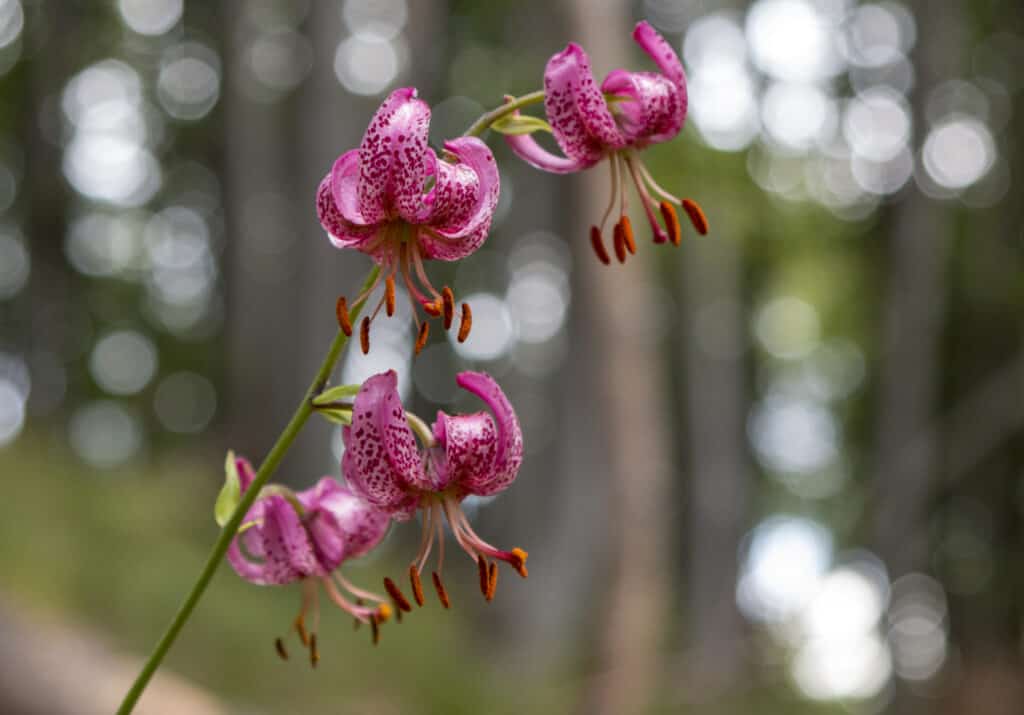
The petals of the Turk’s Cap Lily curve back so much that they resemble a turban.
©iStock.com/Gerdzhikov
L. martagon lilies contain the beautiful Turk’s cap lily. With a height of 3 to 6 feet and a spread of 1 to 3 feet, these lilies are noteworthy for the way their petals curve all the way back to form something like a Turk’s cap. The name martagon is in fact the French version of a Turkish word that means “turban.” The petals are pink or white with maroon spots and the flowers are fragrant and attract hummingbirds and butterflies. Like other lilies, L. martagon lilies grow best in full sun to partial shade with medium water and medium maintenance. These lilies are native to Eurasia and hardy in zones 3 to 8.
Unlike the other lilies mentioned so far, Turk’s cap lilies like their soil to be a little alkaline. Some gardeners find these lilies to be challenging, for not all of them produce flowers during their first year. However, if they are established and given good care, they form colonies, live a long time and are pretty much disease and pest free.
If you live where the summers are really hot and dry, plant Turk’s cap lilies in dappled shade. Choose the site carefully because these lilies shouldn’t be moved once they’re planted. When the foliage dies back, cut down the stems then add some compost or rotted manure to the planting area in the fall.
5. Oriental Lilies
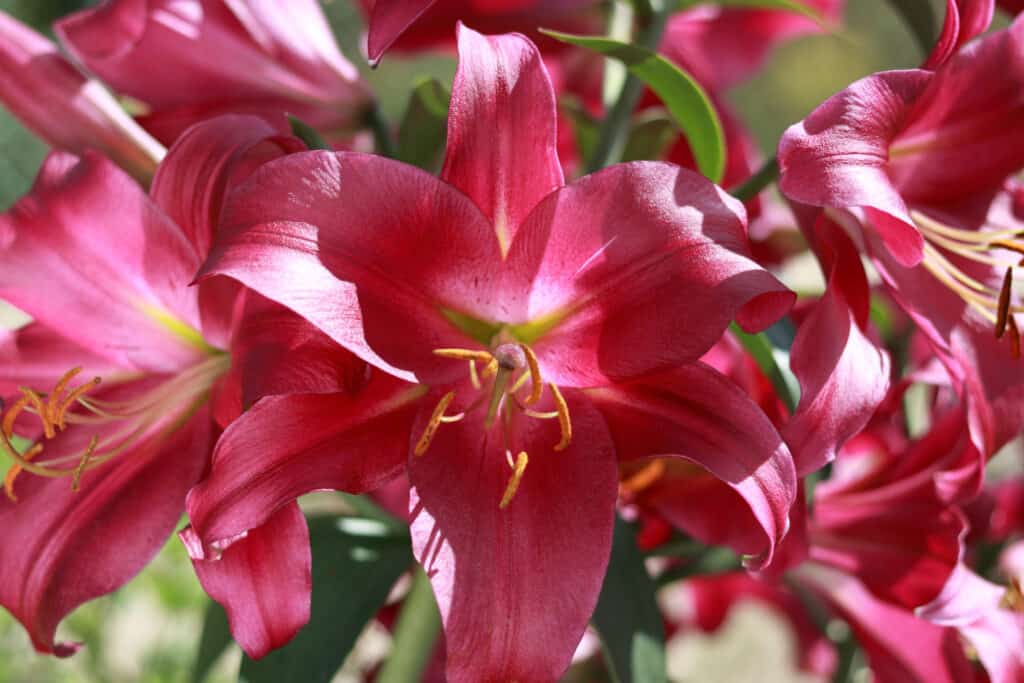
These types of lilies are known for their large, fragrant flowers.
©iStock.com/Mariia Romanyk
Oriental lilies are prized for their beauty and their sweet smell. The most popular kind of these types of lilies are the stargazer lilies, which get their name because their blossoms are upturned and seem to be looking at the stars. These lilies grow to 3 feet tall and have a spread of between 10 and 14 inches. Their flowers, two to eight to a stem, appear in late summer, and they are larger than those of Asiatic lilies. They come in shades of pink, orange, white, yellow, red, and variegated. They thrive in hardiness zones 5 to 9.
Oriental lilies do best in full sun and loamy soil with good drainage. If the soil is clayey, it needs to be amended to prevent it from holding on to water and becoming soggy. The bulbs are best planted 4 to 6 inches deep. Sprinkling screaming hot ground pepper around the planting site should discourage deer and squirrels from digging up the bulbs. Oriental lily stems don’t need to be cut all the way down when the foliage turns yellow, but you should mulch around the site during the fall and remove it when you see shoots appear.
It’s also a good idea to fertilize the lilies in spring with a good bulb fertilizer, and then divide them every three years or so. If the stargazer lilies stop gazing at the stars and flop over, it’s easy to stake them.
6. Madonna Lilies

You don’t need to plant the bulbs of the Madonna lily as deeply as the bulbs of other lilies.
©iStock.com/Mariia Romanyk
Native to the Middle East and Balkan countries, this magnificent lily’s scientific name is L. candidum. The trumpet shaped flowers arrive from spring to the middle of summer. These types of lilies are deliciously fragrant and snowy white and golden at the centers from pollen. The plant grows from 4 to 6 feet in height with a 1 to 2 foot spread and does best in hardiness zones 5 to 9.
Plant the bulbs of the Madonna lily in the fall and space them a half a foot to a foot apart. They aren’t planted as deeply as other lilies and should be covered with only an inch of soil. The best place to plant them is in an area that gets dappled sunlight. Like other lilies, it likes well-drained, fertile soil and prefers the soil to be neutral or just a little alkaline. If you need to add lime to your soil to make it more alkaline, add it well before you plant your bulbs. After planting the bulbs, water them thoroughly but make sure they’re never soggy. When the leaves die after the plant blooms, cut the plant back.
7. Trumpet Lilies
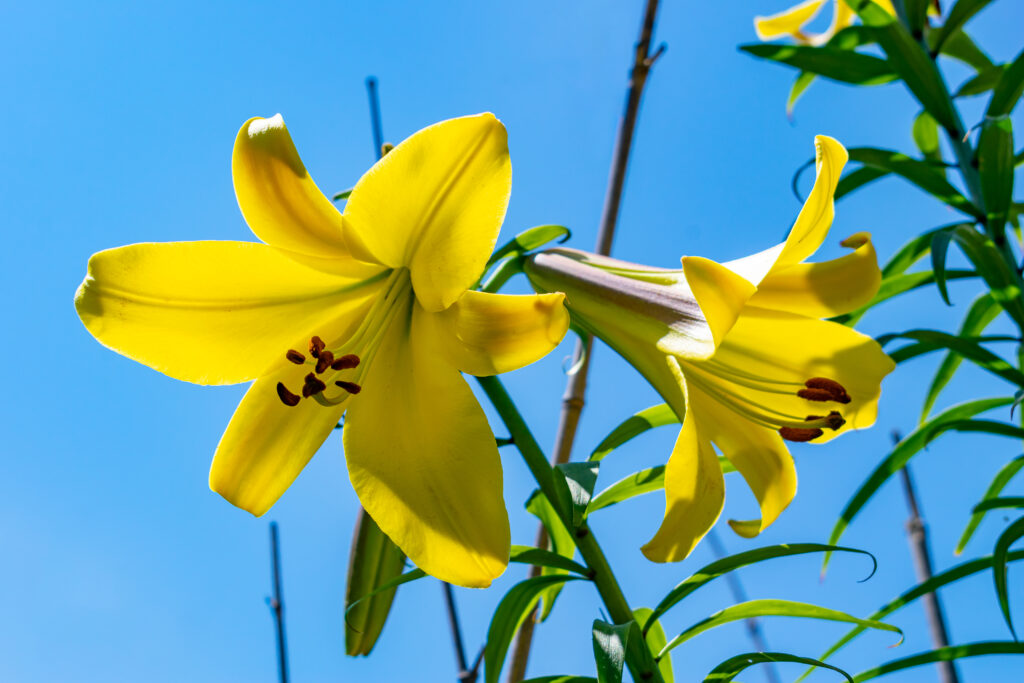
These types of lilies come in a variety of colors including sunny yellow.
©CoinUp/Shutterstock.com
Though some botanists also refer to the Easter lily as the trumpet lily, L. aurelianense is also known as the trumpet lily. These lilies have huge, waxy flowers that can be 6 to 10 inches long and are wonderfully fragrant. Some have backward curling petals and face down or face up depending on the cultivar. They come in shades of pure white to yellow, gold, pink, mauve, or apricot. They can grow as tall as 6 feet. A stalk can produce 12 to 15 blooms in mid to late summer and may need some staking.
Like other lilies, the tiger lily prefers full to partial sun, has average water needs and doesn’t need much care after it’s established. It likes soil that’s loamy, well-draining, and with a pH that ranges from slightly acidic to neutral to slightly alkaline.
8. Interdivisional Hybrids
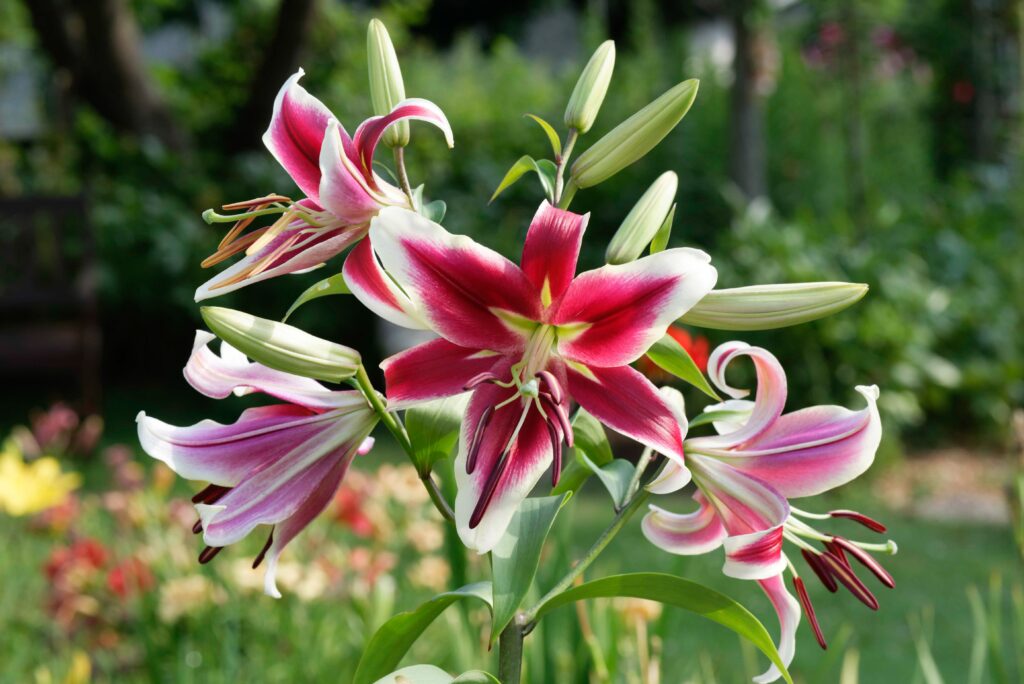
‘Flashpoint’ is a type of Orienpet lily, which is an interdivisional hybrid.
©Walter Erhardt/Shutterstock.com
These lilies are created by crossing lilies from different divisions. The resulting plants are often hardier and have a wider range of colors than their parents. One of these interdivisional hybrids is the Orienpet lily, a cross between an Oriental and a trumpet lily. These lilies are best planted in late fall in a place that gets at least six hours of sun a day. Plant them 2.5 times their height, then cover with soil, tamp them down, water and tamp down again — use your hands and not your feet — to get rid of air pockets. Interdivisional hybrid lilies do best in hardiness zones 4 to 9.
9. Species Lilies
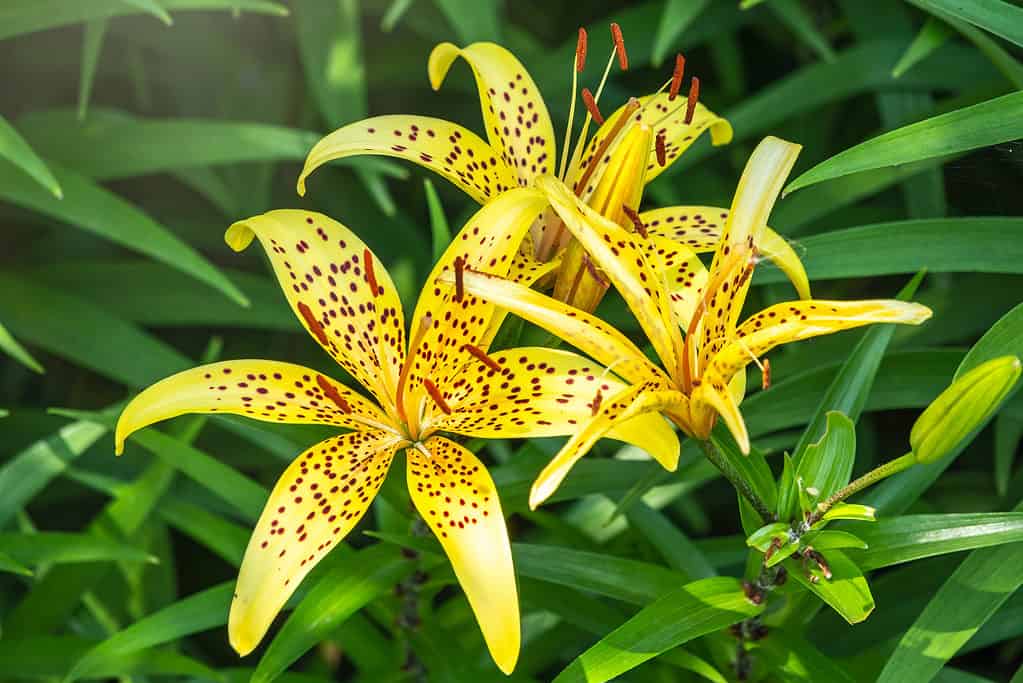
is a wild lily known as the
leopard
or panther lily.
©iStock.com/Dmitry Potashkin
These types of lilies are native to Europe, Asia and North America. They haven’t been hybridized, but they are used to create popular hybrids. As wild plants, they are notably tough. Hardy in zones as cold as Zone 3 and as hot as Zone 10, they’re found in tropical rainforests to the cold slopes of mountains, to canyons and along streambeds. They thrive in full sun to full shade. Some of these lilies are easy to grow in your garden or even in a pot as an indoor plant. Others are a bit of a challenge. Some species lilies include Humboldt’s lily and the leopard lily, both native to California, and the coral lily of Siberia.
Thank you for reading! Have some feedback for us? Contact the AZ Animals editorial team.

